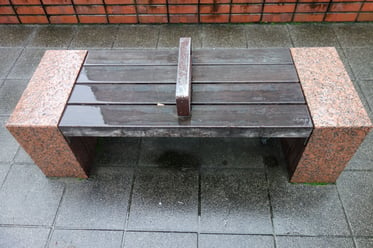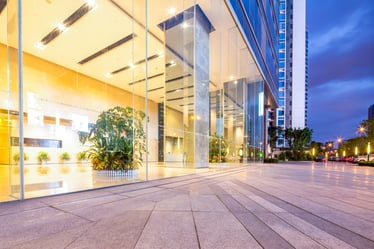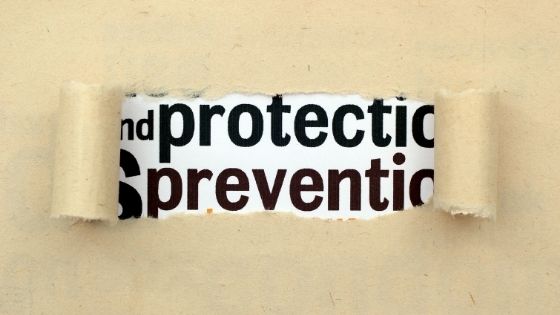Have you thought about improving security in your workplace but don’t have the funding to implement a large-scale project? While security measures such as electronic surveillance systems and fortified doors certainly enhance security, they can be costly and can even create an image of an “urban fortress” rather than a welcoming and user-friendly workplace. An alternative approach is to enhance security through principles of Crime Prevention Through Environmental Design (CPTED).
CPTED is an emerging approach that has been adopted by planners, architects, and security professionals for the design of buildings, sites, parks, and urban renewal projects. The CPTED model emphasizes designing buildings and outdoor spaces in a way that encourages positive behavior and limits opportunities for crime. Simply put, CPTED design strategies make it more difficult for offenders to commit crime. Many CPTED strategies can be applied at a relatively low cost.
There are four basic CPTED strategies that together can be applied to prevent crime – natural surveillance, territorial reinforcement, natural access control, and maintenance. In this blog, I’ll discuss how the first of these strategies - natural surveillance - can be implemented to optimize security in your workplace. Keep an eye out for my future blogs on how the other three CPTED strategies can be applied to the workplace.
Eyes on the Street
Natural surveillance is the placement of physical features, activities, and people in a way that maximizes visibility. In her famous book, The Death and Life of Great American Cities, Jane Jacobs, an urbanist and activist who had a profound impact on planning, coined the phrase “eyes on the street.” Jacobs’ concept suggests that opportunities for crime are substantially reduced when there is activity taking place in an area.
For example, a well-maintained park in an urban community can be used for summer camps, outdoor movie nights, farmers’ markets, and recreational activities. These positive activities draw legitimate users to the neighborhood and park, bringing eyes to the street and increasing natural surveillance, which limits opportunities for crime.
Similarly, workplace security is enhanced when there are eyes on the street. Below are some practical, cost-effective strategies for increasing natural surveillance around your building’s exterior and interior.
Exterior Natural Surveillance Strategies
Develop outdoor gathering spaces. Consider creating some outdoor gathering spaces, such as a patio or grassy area with benches and picnic tables, where employees can take a break or eat lunch. Placement of these gathering spaces is key. Users with an illegitimate purpose are less likely to choose a location where their actions are observable by others.
Benches should have a center armrest to prevent lounging or sleeping and should be located at the building’s entrance points so that legitimate users can observe individuals who are entering and exiting the building.
When possible, benches and picnic tables should also be situated along the sides of the building that have the fewest doors and windows. Creating an outdoor gathering space brings eyes to areas that may have limited surveillance from the interior of the building. Under the CPTED model, this is referred to as bringing a safe activity (employees taking a break or eating lunch) to an unsafe location (exterior portions of the building that are not observable from the interior).
 Divided Bench
Divided Bench
Modify landscaping. Landscaping is a key CPTED strategy for a variety of reasons, including its role in facilitating natural surveillance. It’s important to apply the “2 feet/6 feet” rule to your landscaping design. Ensure that ground cover is no higher than 2 feet from the ground and that the bottom of the tree canopy is 6 feet or higher.
Ground cover that consists of thorny vegetation also helps limit areas of concealment for potential offenders.
Keeping the ground cover low and tree canopy high has the following benefits:
- Maximizes sightlines of building occupants to the parking lot and building exterior
- Maximizes sightlines of users who enter and exit the building
- Prevents obstruction of lighting
- Allows patrolling police to have an unobstructed view of the building
- Reduces potential areas for concealment and ambush points for users with an illegitimate purpose
Conduct a lighting study. Adequate lighting is the #1 deterrent of nighttime crime. Lighting allows building users to observe their surroundings and respond to potential threats. Both the quality and amount of lighting are critical to security.
One of the most important steps you can take to enhance your workplace security is to hire a consultant to perform a lighting survey to determine if your current infrastructure meets the Illuminating Engineering Society (IES) standards. The results of the lighting survey will provide a roadmap for changes that are required to bring your workplace into compliance with the highest lighting security standards.
 Workplace Lighting
Workplace Lighting
Interior Natural Surveillance Strategies
Adjust workstation orientation. Outward natural surveillance, or eyes on the street, can be best achieved by orienting workstations so that employees face windows while sitting at their desks. Employees who have clear, unobstructed sightlines to the building exterior provide a first line of defense in identifying an impending security threat.
For instance, an employee looking out the window may notice a suspicious package or individual outside the building. The employee then has the opportunity to notify appropriate personnel so that the potential threat can be investigated and mitigated. The presence of employees near windows also provides a deterrent effect to users with an illegitimate purpose who may be viewing the building from the outside.
 Workstation Orientation
Workstation Orientation
Reconfigure front desk/main entrance. I recently performed a CPTED assessment of a building that had a beautiful front desk at the main entrance, which created a very welcoming entry. However, there was one big problem. The front desk was oriented such that the receptionist faced a wall with no windows rather than facing the main entrance, which had numerous doors and windows providing views to the outside.
If the same condition exists in your workplace, consider reconfiguring the front desk so that the receptionist or security guard has clear views to the building exterior. This provides the opportunity for the person manning the desk to identify a potential threat in the parking lot or building exterior. Having this extra time to alert appropriate personnel could be crucial to securing the building and protecting the safety of building occupants.
Small Steps Forward
This article is not meant to dissuade you from pursuing physical security projects for your workplace. However, those projects can be costly and may not be feasible in your short-term budget. Optimal security can be achieved when physical security measures are complemented with strategic design. By implementing some of the CPTED strategies highlighted above, you can enhance the current level of security in your workplace in a cost-effective way, perhaps while you plan for larger-scale projects. Every bit helps.




.jpg)
.jpg)
.jpg)
-1.jpg)
.jpg)
.jpg)


.jpg)
.jpg)
-1.jpg)
.jpg)
.jpg)
.jpg)
.jpg)
.jpg)

